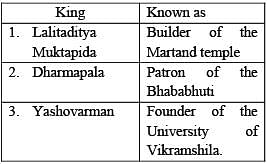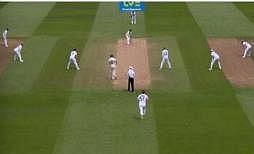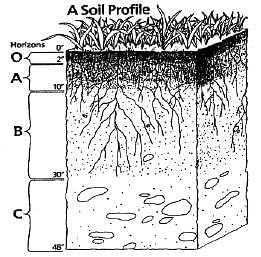UPSC CSE Complete Practice Test - 15 - UPSC MCQ
30 Questions MCQ Test - UPSC CSE Complete Practice Test - 15
Which of the following statements are correct regarding Mangroves?
- Mangrove plants have Pneumatophores roots which help to enhance deposition of sediment in area.
- Mangroves grow in areas with low- oxygen soil.
- They grow luxuriantly in the places where freshwater mixes with seawater and where sediment is composed of accumulated deposits of mud.
Select the correct answer using the codes given below:
Consider the following statements about E-Shram Portal:
- It is launched by the Ministry of Labour and Employment.
- It is a registration portal for unorganized workers.
- Registration on this portal is paid with a nominal charge of ₹50.
How many of the above statements are correct?
With reference to the Ring of Fire, consider the following statements:
- The Ring of Fire is a region characterized by high volcanic activity but no seismic activity.
- The Ring of Fire is primarily located in the Indian Ocean and is home to numerous coral reefs.
- It is associated with frequent earthquakes and volcanic eruptions due to tectonic plate movements.
How many of the above statements are correct?
Consider the following statements about the Strait of Gibraltar:
- It is one of the narrowest straits in the world.
- It separates the Atlantic Ocean from the Mediterranean Sea.
- It was formed as a result of volcanic activity in the last 100 years.
How many of the above statements are correct?
Consider the following freedom fighters:
- Ram Prasad Bismil
- Ashfaqulla Khan
- Sachindra Nath Bakshi
- Jogesh Chandra Chatterjee
How many among the above were the founders of Hindustan Republican Association (HRA)?
Consider the following statements about the BhashaNet portal:
- It is developed by the Centre for Development of Advanced Computing with support of National Internet Exchange of India.
- It provides an ecosystem to enable citizens to easily create, communicate, transact, process and retrieve information with ease in digital medium without language barrier.
Which of the above statements is/are correct?
Consider the following:
- 3D printing
- Quantum computing
- Detection of contamination of food
How many of the areas/fields mentioned above is nanotechnology used?
We feel burning pain when stung by Ant. Which of the following acid is responsible for the burning pain?
Consider the following statements:
- Predictable environment
- The complex relationship amongst species
- Niche similarity amongst species
- More insolation
How many of the above can enhance the biodiversity of the Earth?
Consider the following pairs:
Technologies : Used for
- Gravitational settling : To control air pollution
- Phytoremediation : To control noise pollution
- Electrostatic precipitators : To control water pollution
How many of the above pairs is/are correctly matched?
The Indian Constituent Assembly played a pivotal role in shaping the Constitution of India. In this context, consider the following statements:
- Dr. B.R. Ambedkar was the Chairman of the Drafting Committee of the Constitution.
- Jawaharlal Nehru emphasized the values of democracy, secularism, and socialism, which guided the drafting process.
- Sardar Vallabhbhai Patel played a crucial role in integrating the princely states into the Indian Union.
How many of the above statements is/are incorrect regarding member of drafting committee?
With reference to the Lok Adalats, consider the following statements:
1. They are voluntary agencies, monitored by the State Legal Aid and Advice Boards.
2. It provides for setting up of Legal Services Authorities at the Central, State and District levels.
Which of the above statements is/are incorrect?
With reference to the external trade routes in Post-Mauryan period, consider the following:
- Kalyana
- Sopara
- Muziris
- Arikamedu
How many of the above were the important ports on the western coast of India ?
Consider the following statements:
1. Election Commission is the only electoral management body (EMB) in India.
2. As per the independent model of electoral management, members of Electoral management bodies (EMBs) are not accountable to any government ministry or department.
3. A national population or statistics bureau that produces electoral registers as part of the general process of population registration is not considered to be an EMB.
How many of the statements given above are correct?
Arrange the following historical events on a chronological sequence:
- Second Round Table Conference
- Gandhi-Irwin Pact
- Karachi Resolution
- Execution of Bhagat Singh
Select the correct answer using the code given below.
Consider the following statements regarding crowding out phenomena:
Statement-I: It is the result of an expansionary fiscal policy stance.
Statement-II: Crowding-out results in a decrease in the real interest rate in the economy.
Which one of the following is correct in respect of the above statements?
Consider the following statements:
- The Congress saw the Simon Commission as a violation of the principle of self-determination and an insult to self-respect.
- The anti-Simon Commission Movement immediately lead to a wider political struggle.
- After the Nehru Report, communalism began to grow in India.
How many of the above statements is/are correct?
The term ‘Brumbrella’ was recently seen in the news in the context of which one of the following?
In the context of gravitational force and electromagnetic force, consider the following statements:
- While gravitational force is always attractive, electromagnetic force can be both attractive and repulsive.
- While gravitational force is only dependent on mass, the electromagnetic force is dependent on both mass andcharge.
- While gravitational force is dependent upon the distance between the two bodies, the electromagnetic force is independent of it.
Which of the statements given above is/are correct?
One thick woollen blanket is less warm than two thin woollen blankets joined together to same thickness. Which of the following is the most appropriate reason for the above phenomenon?
Which of the following pairs regarding the pollutants and their sources are correctly matched?
- Sulphur compounds : Oil Refineries
- Nitrogen compounds : Motor vehicle exhaust
- Carbon compounds : Automobile exhaust
Select the correct option using the code given below:
With reference to the early medieval history of India, consider the following pairs:

How many of the above pairs are correctly matched?
Which of the following statements about parthenogenesis is/are true?
Consider the following statements:
Statement-I : Roman gold and silver coins have been found in many places in south India
Statement-II : The southern part of India played an important role in the maritime trade route due to easy access to the coast.
Which one of the following is correct in respect of the above statements?
With reference to the General Elections held in 1945, consider the following statements:
- The Indian National Congress won a majority of seats in the Central Legislative Assembly.
- The Muslim League assumed power in Bengal, Punjab and Sind.
Which of the statements given above is/are correct?
Consider the following statements regarding the Bhartiya Poshan Krishi Kosh project and the Agro-Food Atlas:
- The Food Atlas is a repository of diverse crops across all the 127 agro-climatic zones of India.
- The project depends on the diverse data sources provided by ISRO and NASA among others.
- The project also documents social, behavioral and cultural practices that promote and reinforce healthy dietary behaviors.
How many of the above statements are correct?
Consider the following statements:
Assertion (A): A member country need not to present a declaration of balance of paymentsrelated needs to make a purchase in the reserve tranche.
Reason (R): The reserve tranche is a segment of an International Monetary Fund (IMF) member country’s quota that is accessible without any fees or economic reform conditions.
Select the correct answer using the code given below:
With reference to the ancient Indian history, consider the following statements:
- Kodumanal town of Tamil Nadu was well known for bead-making industry.
- Tortoise shells, sapphires, silk cloth and diamonds were exported from the Malabar coast.
- Major trade between India and the Roman empire was through the Persian Gulf.
How many of the above statements is/are correct?
Consider the following statements:
Statement-I: Article 32 of the Constitution gives an extensive original jurisdiction to the Supreme Court in regard to enforcement of Fundamental Rights.
Statement-II: It is empowered to issue directions, orders or writs, including writs in the nature of habeas corpus, mandamus, prohibition, quo warranto and certiorari to enforce them.
Which one of the following is correct in respect of the above statements?
With reference to the soil profile, consider the following pairs:
Soil Horizon : Soil Component
- Horizon A : Loose parent Material
- Horizon B : Primarily water
- Horizon C : Organic materials
How many of the above pairs are correctly matched?























